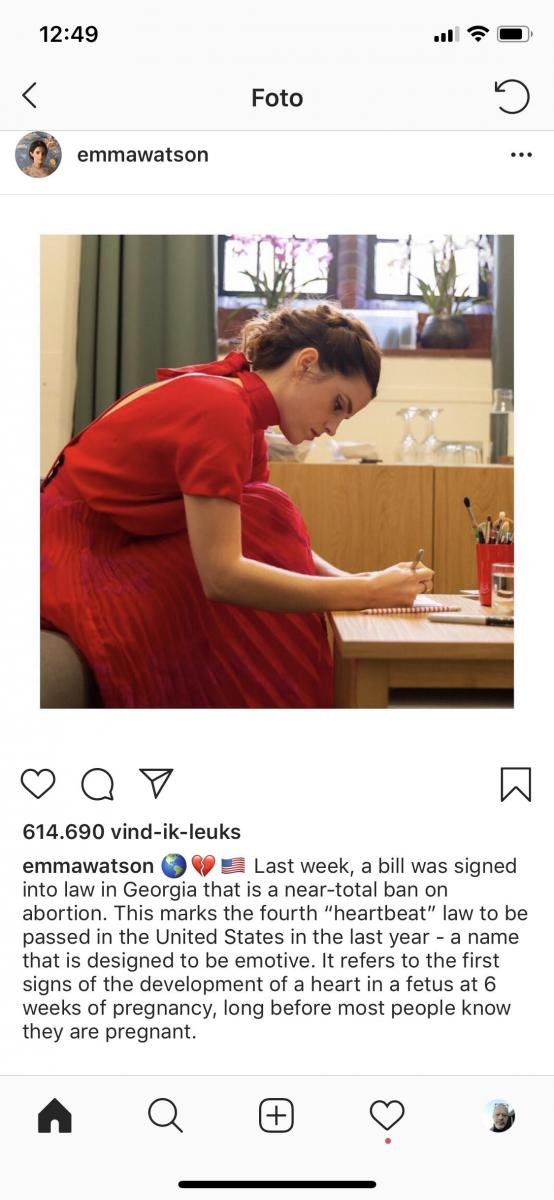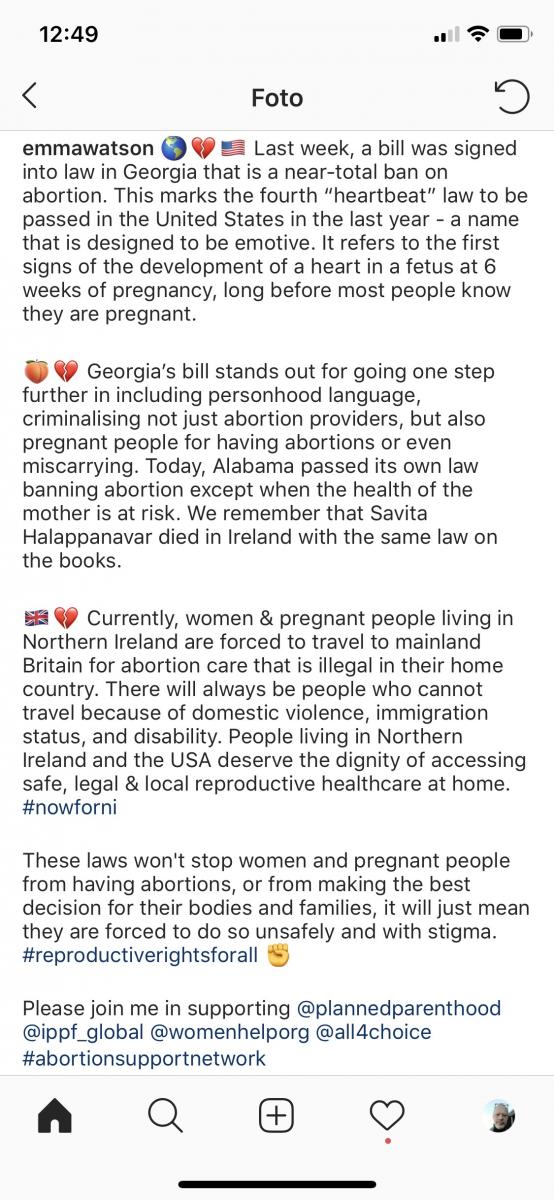
Emma Watson on Framing
Emma Watson has emerged as one of the world's foremost celebrity-activists, campaigning relentlessly for gender equality and against sexual violence in a wide variety of fora. The recent decision of the Alabama legislature to make almost any form of abortion illegal in the state evidently provoked her anger. Yet, her response was remarakable.
Emma Watson the activist
Watson, born in 1990, was propelled towards superstardom by the Harry Potter movies, later followed by a range of major appearances in high-profile Hollywood and television productions. Watson was a child star; the first Harry Potter movie appeared in 2001 and started the first popular-cultural megahype of the century. But she gradually grew into a complex composite public figure: notoriously beautiful as well as intellectual, plebeian as well as patrician, publicly visible as well as withdrawn, kind and thoughtful as well as outspoken and provocative. And above all: acclaimed actress as well as political activist. Watson, after combining her award-winning acting career with a Liberal Arts program in the US, was appointed UN Women Goodwill Ambassador in 2014 - joining the likes of Nicole Kidman.
She consistently articulates an unshakable commitment to equality between men and women, drawing on her own experiences of gender stereotyping and sexualization at a tender age.
It is in that latter role that Watson became a formidable champion of gender equality with a global reach, traveling widely to visit campaigns and projects, attending conferences and making public statements in front of distinguished audiences. She consistently articulates an unshakable commitment to equality between men and women, drawing on her own experiences of gender stereotyping and sexualization at a tender age.
Being a celebrity, Emma Watson is evidently very much present on social media. And here, too, she is impressive. She runs a Twitter account with almost 30 million followers; her Instagram account has over 50 million followers, and her Instagram posts score a whopping 1 to 4 million likes from fellow celebrities as well as from people worldwide. This, by anyone's standards, is being big on social media. The thing is, however, that these accounts are hardly used for what one could call celebrity glam: her social media activities are overwhelmingly political, and she uses Twitter and Instagram as a global gender activist, not as a global moviestar or lifesyle icon. And this takes us to Alabama.
Emma Watson, Instagram and pro-life framing
On May 14, 2019, the Alabama State Legislature (controlled by Republicans) approved a bill in which nearly any form of abortion is outlawed, and in which those who perform the abortion as well as women who are having the abortion are defined as felons, risking very heavy prison sentences. The bill caused widespread outrage, but it wasn't the first of its sort, nor does it look as if it's the last. Abortion has for many years been one of the themes around which extreme polarization has been organized in US public and political debate, and one of the key ingredients of such polarization strategies is framing.
Emma Watson picked that up. Here is part of an Instagram update she posted on May 16, 2019.

Emma Watson Instagram update 16 May 2019
In the remainder of the message, Watson emphasizes that the Alabama bill punishes both the doctors and the women, makes a connection between abortion and sexual abuse, and invokes examples of women having to take grave risks to avoid unwanted or forced pregnancies.
I am focusing, however, on the sentence "This marks the fourth 'heartbeat' law to be passed in the United States in the last year - a name that is designed to be emotive." For in this short sentence, Watson displays an acute awareness and understanding of the power of framing.
The fascinating thing here is that Watson accurately instructs us about what frames do: they create a moral vector in debates.
Those campaigning against abortion, in the US as well as increasingly elsewhere, systematically deploy an expressly emotive and moral vocabulary revolving around what we can call "absolute" features. Thus, they will not qualify their stance as "anti-abortion" but as "pro-life". And since taking a life is widely seen as an absolute moral evil (except, of course, when that life is evil in itself, as when the death penalty is favored to punish murderers), "pro-life" becomes a position which is very hard to assail - for who on earth can be against life?
This, then, enables a string of other related terms to enter. "Life" itself is indexed by means of the word "heartbeat" - a heartbeat is a sign of life, and the heartbeat of a foetus is something that evokes powerful emotions among parents who remember hearing it for the first time. The heartbeat, in turn, projects the image of a "child" (not a foetus), and killing a child is, of course, one of the worst possible crimes, for children are by definition "innocent". Abortion, in this frame, is the murder of an innocent child, and perpetrators must pay heavily for that.
The fascinating thing here is that Watson accurately instructs us about what frames do. They create a moral vector in debates by deploying strings of carefully chosen terms with a strong conventional moral load, and this moral vector starts organizing the debate. The absoluteness of this particular frame - "life" is an absolute, morally positive feature - excludes the very large range of concerns voiced by Watson in her message and by many others in their responses to the Alabama bill. It excludes considering the women whose pregnancy is due to rape or incest, who get pregnant at a very young age, or whose pregnancy can be health-endangering or even life-threatening.
In an even wider sense, it excludes the right of women to make pregnancy-related decisions and effectively precludes family planning - things that used to be widely considered to be important and liberating achievements in gender equality in contemporary societies. Frames organize debates by rendering such considerations not only irrelevant, but immoral and - translated into a "heartbeat" bill - criminal.
Social media and re-framing
Emma Watson's Instagram update received over 600.000 likes in the first hour after posting; two hour later, this figure had more than doubled. As we know, algorithms favor celebrities, certainly when they are followed by other celebrities, and certainly on Instagram - the current social media hub of real and would-be celebrities and influencers.
What Emma Watson attempts on Instagram is to educate her audience, to sensitize them and to reframe issues.
Such media, therefore, present a tremendous potential as learning environments. And what Emma Watson does on Instagram is precisely that: she attempts to educate her audience, to sensitize them to hostile and disempowering frames and to reframe issues such as abortion back in terms of women's rights, equality and freedom.

Full text of Emma Watson's Instagram argument
Celebrities always have influencing potential. The impact of the #MeToo movement, after all, gained seismic proportions due to the very prominent role played by high-power female celebrities, whose social media messages went viral and became the topic of headline news. But what makes Watson's involvement quite exceptional is the specific way in which she uses media such as Instagram. While other superstars (e.g. Lady Gaga) voiced their anger in crisp, emotional and dismissive messages, Watson offers a long, reasoned and rich argument, judiciously sprinkled with a handful of emojis, exposing several crucial issues that must be raised as objections against the Alabama bill. She teaches her followers how to respond to the "pro-life" frame: by exposing all those elements that the "pro-life" frame excludes from the question.
What we see here is how a global entertainment icon is gradually turning a social medium designed to showcase her as a star into a medium for mass education, for serious big-issue campaigning and sensitization, and for mobilizing a more enduring public opinion around the themes she has chosen. She is stretching the affordances of a medium such as Instagram into directions not scripted by its designers, and she does so in an effective way. This is clever game-changing media work, and it deserves more analytical attention than what I could give it here. For it shows us how specific media can be functionally retailored by people who think not just about what is expected and desirable, but also about what is possible on such media.